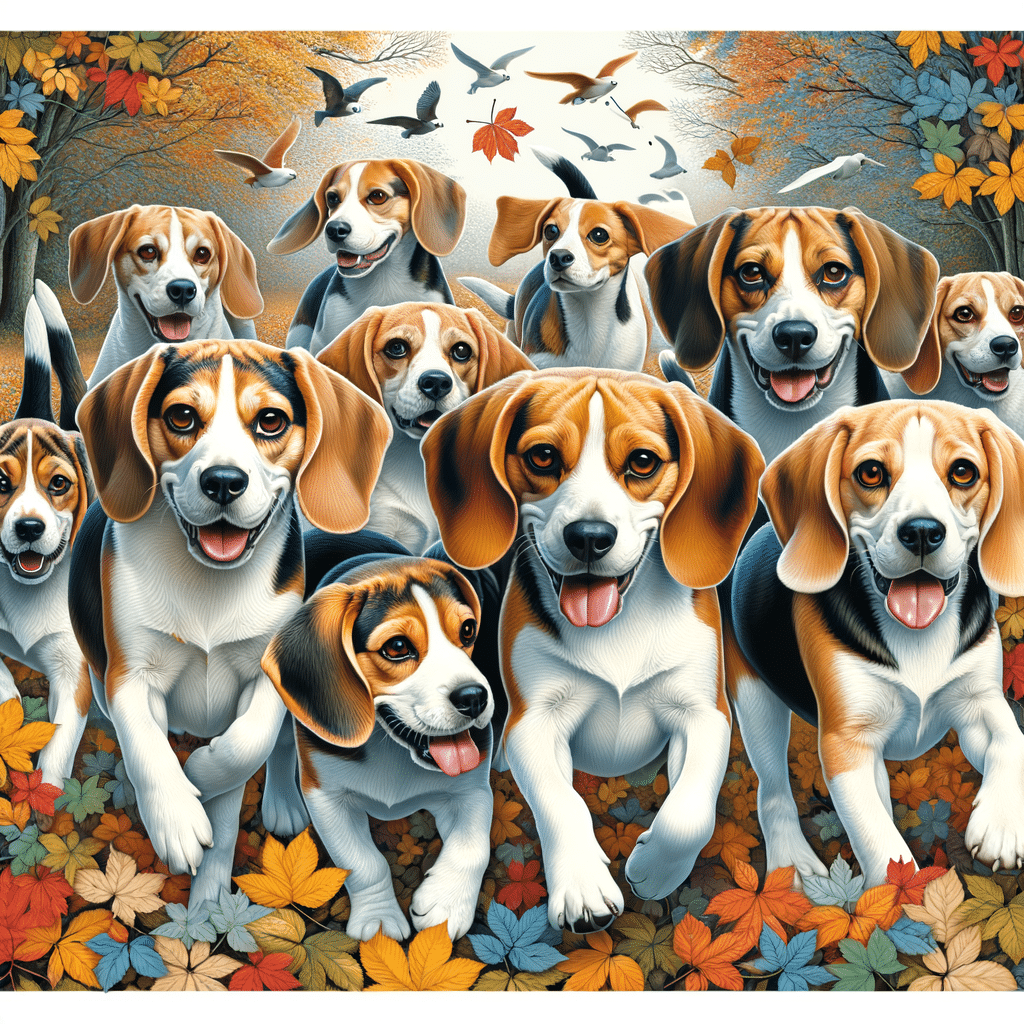The beagle and bluetick hound mix is a crossbreed that merges the qualities of two well-loved hunting dogs. The beagle, a small hound with a keen sense of smell, is widely recognized for its energetic and friendly nature. The bluetick hound, known for its striking coat and acute tracking abilities, lends its distinct traits to this mix.
In This Article
Together, they create a hybrid dog breed that is both companionable and adept at scent work, making them a potentially ideal fit for families and individuals who appreciate an active, outdoorsy lifestyle.
Owners of beagle and bluetick hound mixes can expect a dog with a blend of physical characteristics that reflect its parentage. These canines often have the bluetick’s signature mottled coat alongside the sturdy build of a beagle.
Regarding personality, they typically inherit the beagle’s sociability and the bluetick hound’s determined nature, resulting in a friendly yet tenacious temperament. As with any crossbreed, health and care considerations are paramount, drawing from both breeds’ common issues and needs.
Highlights
- The mix combines the beagle’s sociability with the bluetick’s tracking prowess.
- Expect a friendly temperament and a coat that may reflect the bluetick’s mottling.
- Health care draws from both breeds, emphasizing the necessity of informed ownership.
Breed Origins and History
The beagle and bluetick coonhound mix draws from a rich lineage of two distinguished hunting dogs, combining the beagle’s English heritage with the American-bred bluetick coonhound’s prowess.
Beagle Background
The beagle breed originated in England, where it was prominently developed in the 1830s for hunting purposes. They are small—to medium-sized scent hounds known for their acute sense of smell and tracking capabilities. Reverend Philip Honeywood established an early notable beagle pack in Essex, England, which contributed significantly to the breed’s lineage.
The two beagle dog breeds that had the most influence on beagle breeding were the Southern hound, a likely ancestor contributing robust scent-tracking ability, and the North County beagle, which influenced size and agility for hunting.
The American Kennel Club (AKC) officially recognized Beagles in 1885, signifying the breed’s esteem and popularity.
Bluetick Coonhound Heritage
The bluetick coonhound emerged distinctly in the United States with a reputation as an exceptional hunting dog. Known for its striking blue-ticked coat and relentless tracking capabilities, the bluetick coonhound originated from the coalescence of several hound breeds, including the English foxhound and various French hounds.
The bluetick hound is officially recognized by the AKC and acknowledged as a member of the hound group. It is also recognized by the Canadian Kennel Club, indicating the breed’s widespread presence in North America.
Throughout history, each breed brings forth specialized hunting traits that make the beagle and bluetick hound mix a remarkable hybrid of two proficient hunters.
Physical Characteristics
The beagle and bluetick hound mix is a distinctive hybrid with notable traits from both breeds. This dog tends to inherit the beagle’s muscular build along with the bluetick hound’s unique color patterns.
Appearance and Size
The beagle and bluetick hound mix usually reflects a balanced physique with a sturdy build indicative of its hunting lineage. They generally possess a muscular frame and carry themselves with confidence.
The size of this hybrid can vary, largely depending on the predominant genetic contributions from either parent breed. They commonly weigh between 20 and 35 pounds and stand 13 to 24 inches at the shoulder.
Coat and Color Variations
Their coat type is typically short, dense, and smooth, providing a hardy covering suitable for varied climates. The most striking aspect of this mix is the coloration, which incorporates blueticking—small, evenly dispersed blue or black spots on a white background—inherited from the bluetick hound.
This breed’s coat color is often part of a tricolor pattern. Tan appears over the eyes, on the face, and on the legs. White commonly serves as the base color. Blueticking, unique spots, or “ticking,” are found in the white areas.
Rarely, variations include red, lemon, or a more pronounced tricolor pattern, which includes a combination of the above standard colors enriched with distinctive blueticks.
Behavior and Temperament
The beagle and bluetick hound mix, commonly known for its active and friendly demeanor, inherits a blend of traits that make it a sought-after companion for active families. This mix usually results in a dog with a strong sense of smell and a desire for companionship.
Personality Traits
The personality of a beagle and bluetick hound mix is often described as intelligent and amiable. They are typically active, enjoying ample playtime and excelling in environments where they can burn off their copious energy. However, they may display a stubborn streak, a common trait of the hound breeds. As a result, they thrive with consistent socialization from a young age to nurture their inherent friendliness.
Training and Exercise Needs
Training these mixed-breed dogs requires patience due to their intelligence, sometimes accompanied by a stubborn temperament. A focus on positive reinforcement works best, rewarding their successes and encouraging their natural inclination to please.
Due to their active nature, the beagle and bluetick mix needs regular exercise to keep them content. Adequate daily exercise can range from long walks to active play sessions, which address their physical needs and stimulate their strong sense of smell and inquisitive mind.
Health and Care
When considering the health and care of a beagle and bluetick hound mix, one must be attentive to their specific needs, particularly common health issues and grooming and maintenance requirements. These dogs inherit traits from both parent breeds, affecting their overall well-being and care approach.
Common Health Issues
The beagle and bluetick hound mix can be predisposed to certain health issues. They may inherit conditions such as hip dysplasia, an abnormal formation of the hip socket which can lead to lameness and arthritis. Ear infections are also common due to their floppy ears that can trap moisture and debris. Monitoring and early detection of these issues are critical.
Epilepsy is another concern and manifests as recurrent seizures. Responsible breeding practices are crucial to minimize the incidence of genetic conditions like epilepsy. This mix may also be prone to cherry eye, a condition where the gland under the eyelid prolapses, causing a red swollen mass in the corner of the eye.
- Hip dysplasia: Regular check-ups and weight management can reduce risks.
- Ear infections: Routine ear cleaning to prevent infection.
- Epilepsy: Seek veterinary care for management.
- Cherry eye: This can often be corrected with surgery.
A beagle and bluetick hound’s lifespan typically ranges, but owners can enhance their dog’s quality of life by being vigilant about these potential health concerns.
Grooming and Maintenance
Grooming a beagle and bluetick hound mix isn’t overly complex, but it is important for their health and comfort. They are not hypoallergenic and will shed somewhat, so regular brushing is necessary to remove dead hair and distribute skin oils.
- Brushing: Weekly, to manage shedding and keep the coat healthy.
- Bathing: As needed, but typically infrequently to maintain natural skin oils.
Mental stimulation is paramount for these active, intelligent dogs. Being scent hounds, they benefit from activities such as tracking exercises or hunting games, which also serve as beneficial mental and physical exercise. Maintaining their mental well-being is as important as their physical state, helping to prevent behaviors related to boredom or anxiety.
In terms of the ears, regular checks and cleanings are necessary to prevent infections, and nails should be trimmed regularly to avoid overgrowth and discomfort. By establishing a consistent grooming routine, owners will not only keep their dog looking its best but will also have regular opportunities to check for any signs of health issues that may arise.
Frequently Asked Questions
This section answers common queries about the beagle and bluetick hound mix, providing potential owners with essential information on their traits, care, and compatibility with families.
What are the common traits of a beagle and bluetick hound mix?
The beagle and bluetick hound mix tends to inherit a strong sense of smell, a friendly demeanor, and a notable eagerness for tracking from both parents. They are often sociable and energetic and possess a distinctive baying howl.
What is the average lifespan of a beagle and bluetick hound mix?
Typically, a beagle and bluetick hound mix can be expected to live between 10 to 15 years, assuming they receive proper care, nutrition, and regular veterinary check-ups.
How trainable is a bluetick-beagle mix, and what are their training needs?
A bluetick-beagle mix is quite trainable but requires patience due to the beagle’s sometimes stubborn nature. They thrive on positive reinforcement and consistency, with a requirement for mental stimulation to prevent boredom.
Can you describe the physical characteristics and size of a beagle and bluetick hound mix?
The mix usually features a muscular body, a domed skull, and long ears typical of both breeds. They stand about 13 to 24 inches tall at the shoulder and can weigh between 20 to 35 pounds, with some variation based on their parent’s size.
What level of shedding should be expected from a beagle and bluetick hound mix?
They are moderate shedders and will require regular brushing to manage loose fur and maintain coat health; more so during seasonal changes when shedding may increase.
What are some considerations when adopting or purchasing a beagle-bluetick hound mix puppy?
Prospective owners should consider the mix’s need for exercise and companionship, potential for vocalization, and prey drive. It’s important to also research the reputable breeders or shelters and understand the health clearances for both the beagle and the bluetick hound breeds.






